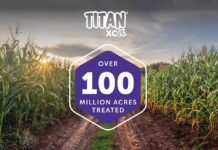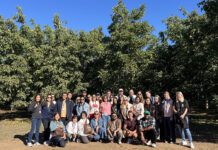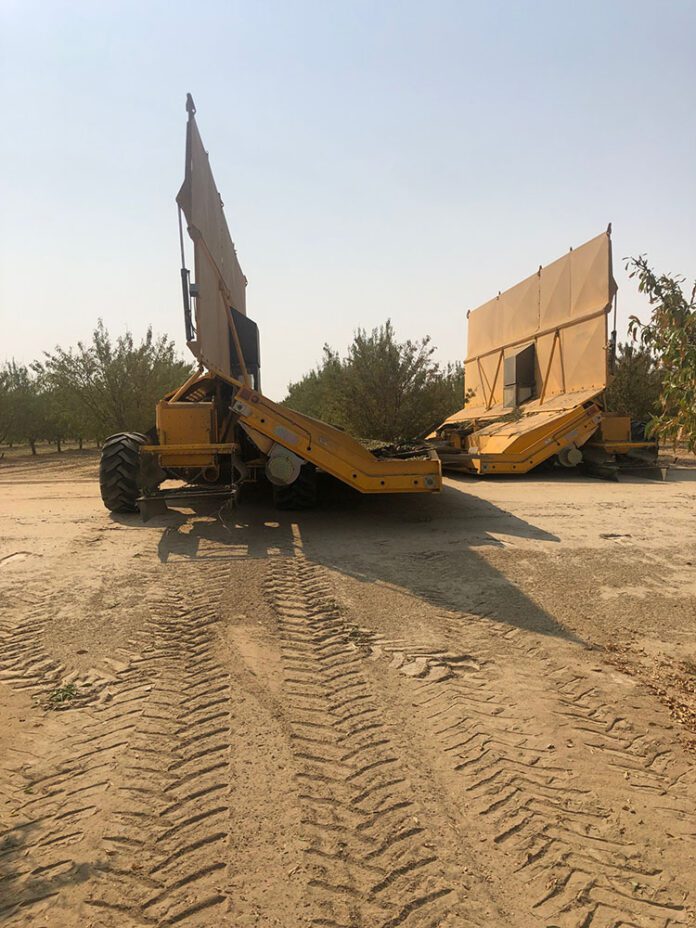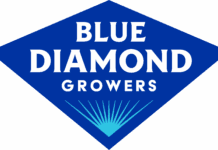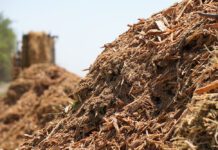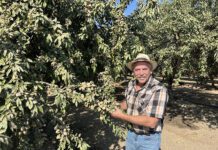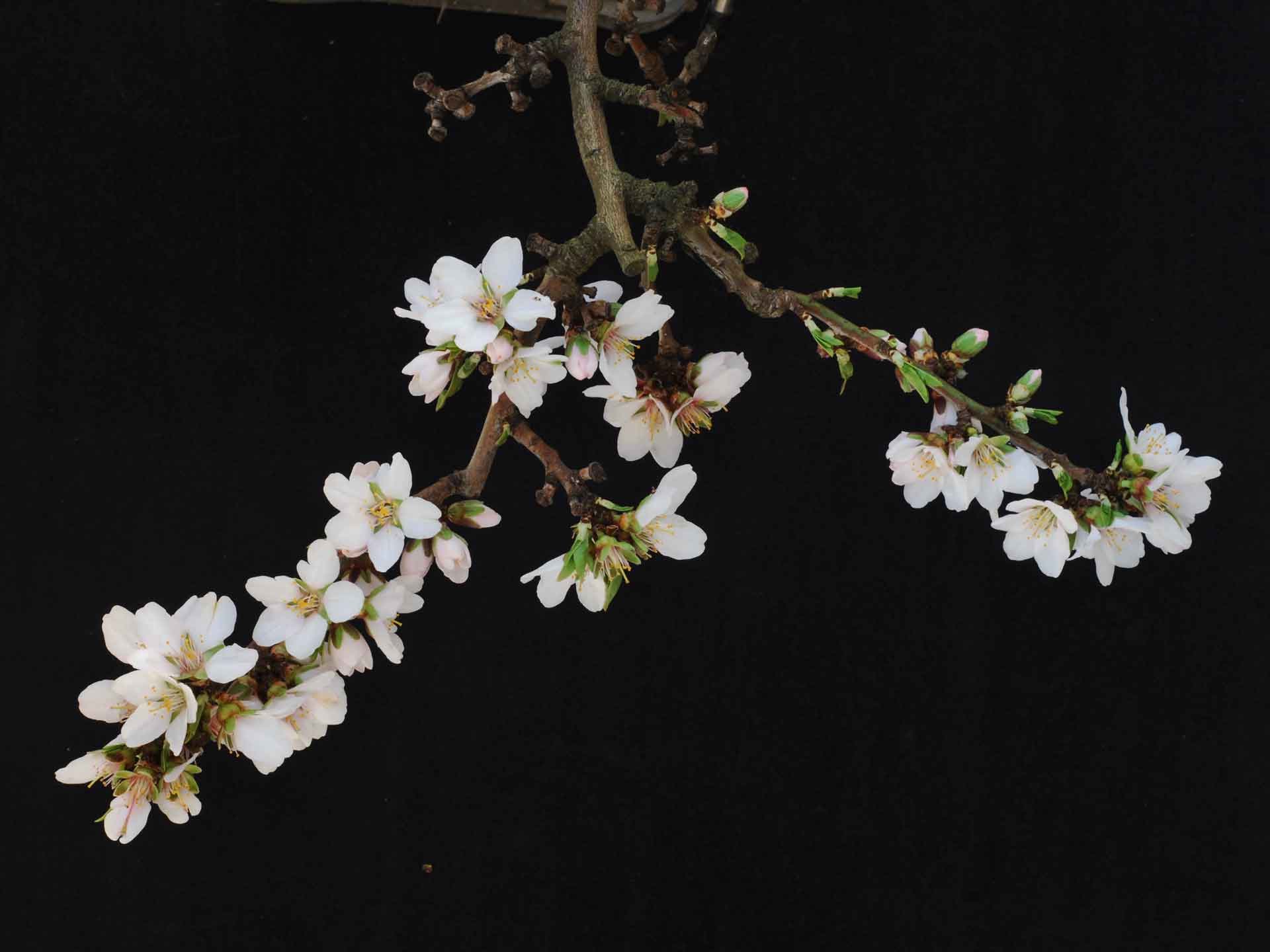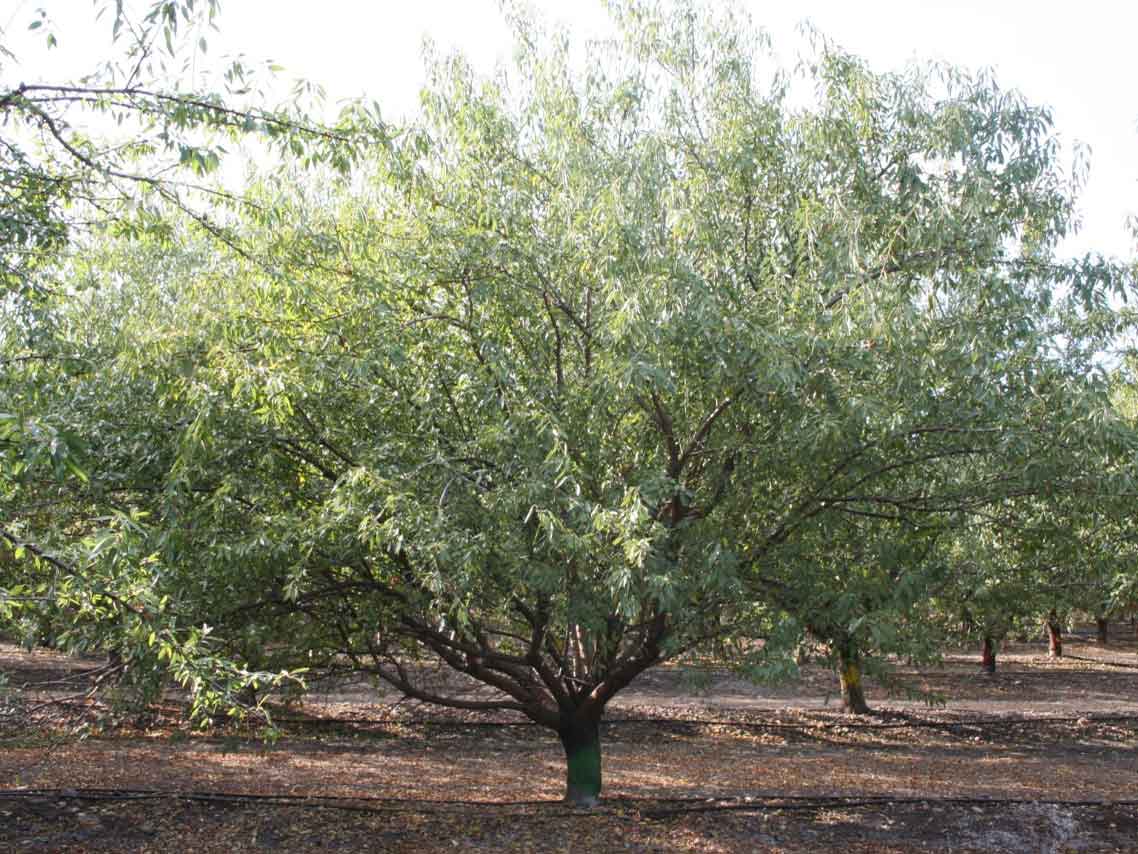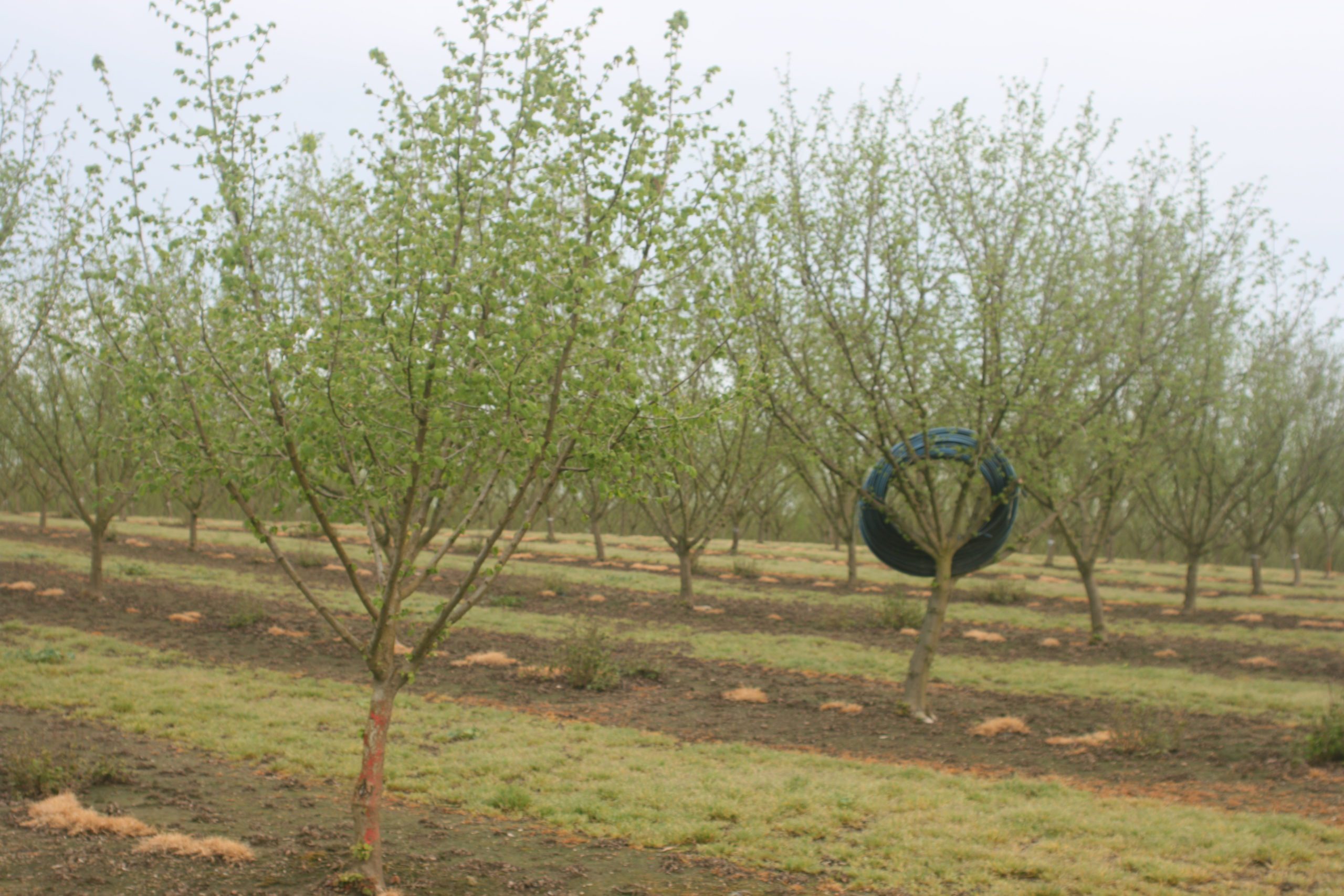A new study is examining the updated economics of off-ground harvesting in almonds to reflect changing economic conditions in the orchard and the market. Research was done six years ago to determine if off-ground harvest really makes sense from an economic standpoint. Initially, two different harvest methods were researched: conventional and fully off-ground. Mechanical drying and natural drying on adjacent ground were also in the research, according to Sebastian Saa, associate director of agricultural research for the Almond Board of California (ABC).
“We just initiated a new project to refresh the original study with the same researcher, Dr. Simmons from UC Davis, because input costs and labor costs etc. have changed a lot in the last six years since that study came out,” Saa said, adding the semi off-ground harvest scenario and conditioning the product will also be included during this study update by the end of the year.
ABC also approved a project with Dr. Stefano Foresti at UC Merced to understand how to manage stockpiling, do demonstrations and they’re piloting different ideas with different growers around the valley as well as hullers. Dr. Zhongli Pan at UC Davis has been working on research for multiple years on different almond drying techniques including mechanical drying, the costs which can be less than 5 cents per pound and even as low as 1.5 cents per pound, which is very inexpensive, Saa said.
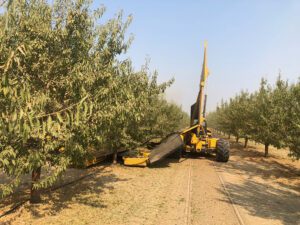
Almond Harvesters
Conventional harvest is a three-part process: shake, sweep and pickup. The nuts are typically shaken to the ground by a side mount or boom shaker. They remain where they fell for several days or weeks to dry depending on drying conditions and ant pressure. After they dry, they are windrowed and picked up.
Another option is a full off-ground harvester where a catch-frame goes under the tree, and when the tree is shaken, the nuts fall onto the catch-frame and are dried in a different location. There is also a semi off-ground harvester using the same catch-frame, but the nuts are relocated to the middle of the row using natural sunlight to dry then collected.
Can growers use a pistachio harvester for off-ground harvesting? The short answer is yes, but there are modifications that need to be done to the machine, Saa said.
“Sometimes the answer is no because the pistachio harvester may be too small,” Saa said. “If it’s a side-by-side harvester, it may have to be retrofitted so the frames can be lower than usual to clip the almond trees before the scaffolds.”
If the almond orchard is still in development, or it has smaller trees, or it is a high-density planting where they are not as big, then it’s much more doable, Saa said.
Another potential harvester is the over-the-row harvester being used in Spain to harvest super-high-density almonds. This harvester is also used in California for olive harvest.
For growers with the high-density plantings the over-the-row harvester would be the better choice, but every trunk must be straight, according to Jonathan Guido, a PCA, agronomist, independent consultant and owner of Terra Nostra Ag.
“You don’t want trees leaned over too far or one trunk leaning too far over because that machine doesn’t have a lot of wiggle room,” Guido said, adding wire trellis may be the future so that every trunk is true.
“Whether it’s a high-density planting of a 10-foot spacing to a 3-foot spacing on a dwarf rootstock, you’re starting to see more trellis utilization rather than each stake and tying,” he said. “And I think over time because of labor costs, these trellis models are coming about more and more on almonds,” adding mainly to reduce labor on staking and tying.
For the catch-frame harvester, any orchard being developed or redeveloped must have a larger head spacing to accommodate it, Guido said.
“I think OMC and TOL have done a really good job of adapting the machines to be more low profile so they can accommodate older trees that never really had the trunk space to accommodate a catch-frame,” he said. “They’ve readapted their machines to fit that model.”
“I think it depends on the orchard configuration whether you can do off-ground harvest or not. Some orchards that were designed with a square configuration, very big trees, those options might not be adequate for off-ground harvest today or tomorrow, while the newer orchards with a little higher-density over-the-row, like 12 to 14 feet by 21 feet, may be more friendly than what we’ve seen in the past,” Saa said.
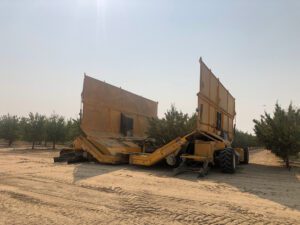
Benefits of Off-Ground Harvest
There are many potential advantages to off-ground harvesting, Saa said.
• Dust reduction during harvest
• Potential for less herbicide use
• Less navel orangeworm (NOW) damage
• Improved soil health and soil water holding capacity
• Reduced water stress on the trees
• Fewer field passes
• Less soil compaction
• Reduced labor
Off-ground harvest is flexible and irrigation can resume immediately, creating less stress on the trees. In a conventional harvest, the trees could go a week to three weeks or more without irrigation while the nuts are drying on the ground.
While irrigation can be resumed sooner with off-ground and semi off-ground harvest, microjets can be tricky and must be adapted, Guido said.
“If it’s a fan jet that has a broader pattern, you could have water run into the windrow,” he said, adding typically growers open up both sets, and under low pressure, they are running with just enough water to keep the stress off the trees so they don’t prematurely defoliate.
“Guys that are on double-line drip, they’ll go ahead and apply a quarter inch of water before pickup just to get the stress off the trees,” Guido said. “The nice thing here is you can actually shake, have it windrowed, have water on by the next day and the trees really don’t miss the water.”
“Fully off-ground will have more labor savings than semi off-ground harvest, but both potentially save labor,” Saa said, adding and not only during harvest activities.
For harvesting, there’s no sweeping, which means less passes and less labor for one machine. In terms of cultural practices, there’s less weed control, so mowing two to four times with semi off-ground or maybe even no mowing with fully off-ground harvest.
“You can potentially reduce your weed management spray applications by half if you do semi off-ground, maybe even more if you do fully off-ground,” Saa said.
Off-ground harvest tends to start earlier, which means less exposure for NOW as long as they shake cleanly from the tree, Guido said. But going in too early the nuts might not come off, so shaking at the right time is important too, he added.
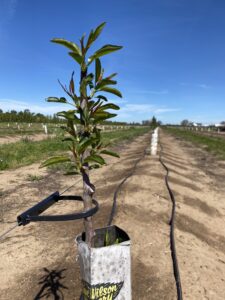
Disadvantages to Off-Ground Harvest
The limitations of off-ground harvest include:
• Cost of equipment
• Possible reconfiguration of the orchard
• Windfall (premature fall of the nuts before harvest or outside the catch-frame system)
• Stockpiling the nuts
Stockpiling the nuts is a challenge. “We are studying how to dry stockpiles very fast because you’re working with a wetter product since you’re not drying it on the floor, so you need to either use mechanical drying or manage your stockpiles in a way that they assist with a drying,” Saa said, adding stockpiling management may have to happen at the processor level as well as the orchard level.
Guido agreed drying is a challenge for off-ground harvest. “I think one of the biggest things is making sure growers understand the moisture content of the hull and kernel before harvest,” he said, adding it’s important to make sure there isn’t too much moisture that can create mold in the orchard.
Some growers have hand held moisture meters, so they’ll check the moistures to determine when to pick up the nuts, Guido said.
Orchards that are younger, have smaller trees and aren’t overgrown and shade out will dry quicker compared to established orchards that have more shade out, Guido said.
Grain growers have used silos for drying their product, and Guido thinks it’s a possibility almond growers could use a silo model for drying too, but it needs to be researched to determine if it could pay for itself. It could help with stockpiling and reduce trucking costs because they would be delivering less foreign material like dirt, sticks and leaves.
“I know it sounds crazy, but if you look at it as 35-year investment, that silo can pay for itself because you should be delivering cleaner product, just kernel, hull and shell,” Guido said.
Conditioning
Many growers are conditioning their almonds whether they do conventional or off-ground harvest. The windrows are conditioned, meaning leaves and dirt are blown out, then the nuts are dropped back on the orchard floor in a wide, shallow windrow to dry out in the orchard middles.
It’s basically a precleaning of the nuts, Saa explained.
“Growers have observed the product is cleaner, has less debris and therefore they save on their shipping costs. We’ve seen a significant adoption of conditioning and we didn’t have that when we did that economic study,” he said.
The Future
The San Joaquin Valley Air District board voted recently to increase their incentives for purchasing low dust equipment such as off-ground harvesters, Saa said, adding as the initiative moved forward, almond prices crashed and input costs rose in the last three years, which resulted in fewer purchases of new equipment.
“Regulatory constraints and costs are going to have growers start rethinking how they develop an orchard and what they can do to reduce dust particulates in the air and contribute to ABC’s harvest dust reduction goals,” Guido said.
“There is some savings to be made if you move from conventional to off-ground harvest. If you put everything together, you can maybe save $150 per acre based on our 2019 study,” Saa said, adding he’ll be able to answer that question more accurately once he has the updated study from UC Davis.





